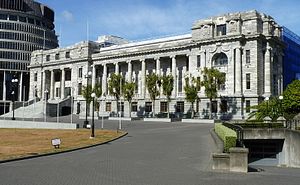After a close fought campaign that energized voters, New Zealanders will be left waiting for a few more weeks to learn the winner, after Saturday’s general election left no single party immediately able to form a majority government.
The ruling center-right National Party, seeking a fourth term under Prime Minister Bill English, received the largest share of the vote at around 46 percent or 58 seats, only a small drop on its total at the 2014 election. The opposition Labour Party, given a huge boost by new leader Jacinda Ardern, bounced back to 35.8 percent, its best result since 2005. Labour’s close partner the Greens garnered 5.9 percent, meaning between them the center-left parties have 52 seats, some way short of the 61 needed for a majority. But with a record 384,000 special votes still to be counted, it is likely Labour and Greens will pick up extra seats. This leaves the populist New Zealand First Party, led by veteran MP Winston Peters, holding the balance of power with a 7.5 percent share and 8 seats.
On current numbers two options look most likely: a National-New Zealand First majority coalition government, or some combination of Labour, Greens and New Zealand First, possibly with the Greens outside government but offering support on confidence and supply. With almost 1 in 2 voters backing his party English is squarely in the box seat and confident he can do a deal with Peters to deliver “strong, stable government.” Peters says he is in no hurry to decide. No outcome looks likely before special votes are formally tallied on October 7.
Either way, the maverick Peters has been here before. After New Zealand’s first election under its Mixed Member Proportional (MMP) system in 1996 he spent six weeks in torturous negotiations with Labour and National, famously announcing he was taking a break to “go fishing” before finally choosing to opt with National. In 2005, after initially insisting he would stay out of government and shun the “baubles of office” he was persuaded to join Helen Clark’s third-term Labour government as foreign minister.
What would a government that includes New Zealand First mean for the country’s foreign policy settings? Peters has been a fierce critic of immigration, foreign (particularly “Asian”) investment and property sales, and free trade agreements. In March he warned that New Zealand needed to show “great caution” before signing up to China’s Belt and Road Initiative and he has decried the Trans-Pacific Partnership as only having benefits for “international corporate rackets.”
It’s tempting to draw some parallels with the “America First” agenda of President Donald Trump. But as Clark’s foreign minister Peters was much more orthodox than some of his fiery anti-establishment rhetoric might have suggested. He secured a huge budget increase for the country’s foreign ministry and oversaw a significant warming in US-New Zealand relations. He occasionally railed against negotiations for a NZ-China Free Trade Agreement, but the agreement nonetheless moved ahead under the watch of the Trade Negotiations Minister Phil Goff.
There are also few signs the 72-year old Peters is interested in a second stint as foreign minister. International issues were missing in action during the six-week campaign, which was dominated by issues like the housing affordability, inequality, tax and child poverty. In terms of extracting policy concessions from National, Peters might demand some tightening of immigration rules, but he is likely to be far more interested in building a domestic legacy for himself and securing economic rewards for his home region of Northland.
On the other hand, if Labour and the Greens do find themselves joining Peters in power, it won’t be long before the alignment of their foreign policy preferences is tested. The November APEC Leaders meeting in Danang will be a crucial date for determining the fate of TPP-11. New Zealand, along with Australia and Japan, has already ratified the agreement, but Ms. Ardern says she wants to reopen the deal to allow New Zealand to ban foreign buyers of property, something she also wants to renegotiate into the 2015 New Zealand–South Korea free trade agreement. She has been careful to allow herself a little wiggle room, but the Greens and New Zealand First will want no part of TPP.
On defense, the clock is also ticking on important investment decisions set out in the 2016 Defense White Paper. The National government was supposed to make a call about buying new maritime surveillance aircraft in June but sensing political risk, decided to punt until after the election. Labour has said it broadly supports the upgrades outlined in the White Paper, but committing billions to new defense spending has become a more complicated political proposition after an election focused on fighting homelessness and child poverty. Labour, the Greens and New Zealand First also opposed the extension of the New Zealand Defence Force’s training mission in Iraq until November 2018. It’s unclear if they would seek to end it early.
For the time being a National-New Zealand First coalition looks more probable, meaning a good deal of “steady as she goes,” even if Peters’ pronouncements will make it harder for the government to portray itself as a champion of trade liberalization.
But even if a center-left coalition prevails, changes to New Zealand foreign and defense policy are only likely at the margins. Its TPP dissent notwithstanding, Labour has given backing to supporting new trade agreements with the Pacific Alliance and an upgraded NZ-China FTA. All parties see multilateral institutions as a vital part of the country’s preferred way of engaging on global and regional issues. Australia remains the essential partner and ally, occasional frictions notwithstanding. And the close relations that have blossomed with both Washington and Beijing over the last decade seem set to continue.
David Capie is Director of the Centre for Strategic Studies at Victoria University of Wellington, New Zealand.

































